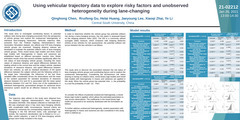报告详情
How to optimize the feature selection for the prediction of lane-changing intention? A meta-analysis
编号:4
访问权限:仅限参会人
更新:2022-06-21 21:21:07
浏览:370次
张贴报告
摘要
Lane-changing behavior is one of the basic driving behaviors and a main contributor to rear-end and sideswipe collisions. Efforts have been devoted to mitigating the hazard risk attributed to lane-changing behavior, by reducing driver’s workload and eliminating human error in the lane-changing process. To this end, it is crucial to have robust prediction of driver’s lane-changing intention for the development of automated driving technology and advanced driver assistance system. Taking the advantage of advanced video image recognition and traffic detection technologies, it is possible to capture comprehensive environment, traffic and driver data for the calibration of prediction model for the lane-changing intention. However, it is not yet known that what features are contributing more to driver’s lane-changing intention. In this study, a meta-analysis was conducted to identify the optimal set of environment, traffic and driver variables that can maximize the efficiency and predictive performance of lane-changing intention, based on 26 selected studies, with which the publication bias was accounted using funnel plot and trim-and-fill methods. In addition, random effect regression model was adopted to measure the association between lane-changing intention and possible influencing factors, controlling for the effects of unobserved heterogeneity. Results of meta-analysis indicate that traffic characteristics (β1= 0.42) are more correlated to lane-changing intention, compared to environmental ((β2=
0.42) are more correlated to lane-changing intention, compared to environmental ((β2= 0.38) and driver ((β3=
0.38) and driver ((β3= 0.39) variables, even that the differences are incremental. Furthermore, driver variables were not fully utilized in the prediction of lane-changing intention in previous studies. Overall, findings should be indicative to the development of robust automated driving technology for the vehicle manufacturers and government agencies.
0.39) variables, even that the differences are incremental. Furthermore, driver variables were not fully utilized in the prediction of lane-changing intention in previous studies. Overall, findings should be indicative to the development of robust automated driving technology for the vehicle manufacturers and government agencies.
关键词
one;t;thre
报告人

RUIFENG GU
全部评论
重要日期
-
会议日期
07月08日
2022
至07月11日
2022
-
07月11日 2022
报告提交截止日期
-
07月11日 2022
注册截止日期
主办单位
Chinese Overseas Transportation Association
Central South University (CSU)
Central South University (CSU)
联系方式
- Conference Organizing Committee
- ci******@gmail.com
历届会议
-
2024年07月23日 中国 Shenzhen
第24届海外华人交通协会国际交通科技年会(CICTP 2024) -
2021年12月17日 中国 Xi'an
The 20th and 21st joint COTA International Conference of Transportation Professionals -
2019年07月06日 中国 南京
The 19th COTA International Conference of Transportation Professionals -
2018年07月05日 中国 Haidian District
18th COTA International Conference of Transportation Professionals -
2016年07月06日 中国 Shanghai, China
The 16th COTA conference International Conference of Transportation Professionals -
2013年08月14日 中国 深圳市
International Conference of Transportation Professionals



发表评论